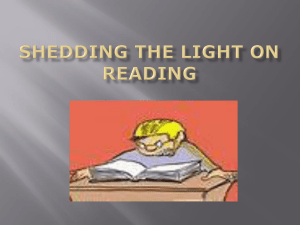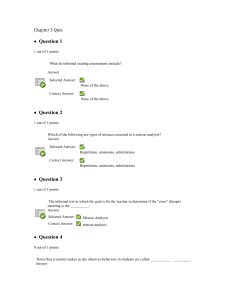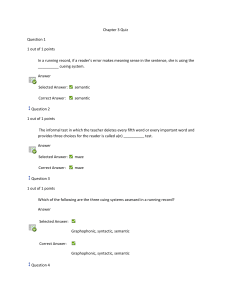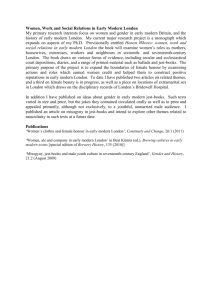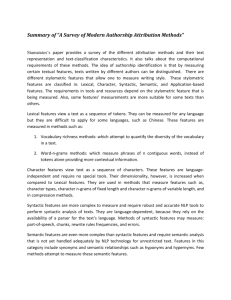Word Document
advertisement
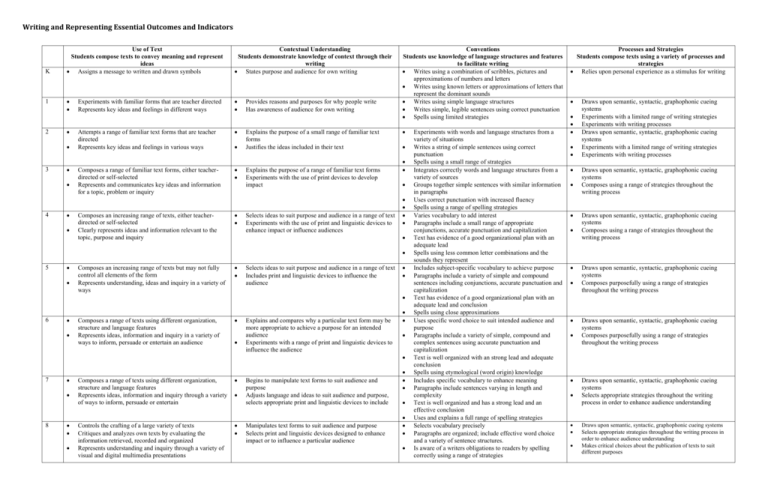
Writing and Representing Essential Outcomes and Indicators K 1 2 Use of Text Students compose texts to convey meaning and represent ideas Assigns a message to written and drawn symbols Contextual Understanding Students demonstrate knowledge of context through their writing States purpose and audience for own writing Experiments with familiar forms that are teacher directed Represents key ideas and feelings in different ways Provides reasons and purposes for why people write Has awareness of audience for own writing Attempts a range of familiar text forms that are teacher directed Represents key ideas and feelings in various ways Explains the purpose of a small range of familiar text forms Justifies the ideas included in their text Composes a range of familiar text forms, either teacherdirected or self-selected Represents and communicates key ideas and information for a topic, problem or inquiry 3 4 Composes an increasing range of texts, either teacherdirected or self-selected Clearly represents ideas and information relevant to the topic, purpose and inquiry Explains the purpose of a range of familiar text forms Experiments with the use of print devices to develop impact Selects ideas to suit purpose and audience in a range of text Experiments with the use of print and linguistic devices to enhance impact or influence audiences Conventions Students use knowledge of language structures and features to facilitate writing Writes using a combination of scribbles, pictures and approximations of numbers and letters Writes using known letters or approximations of letters that represent the dominant sounds Writes using simple language structures Writes simple, legible sentences using correct punctuation Spells using limited strategies 5 Composes an increasing range of texts but may not fully control all elements of the form Represents understanding, ideas and inquiry in a variety of ways Selects ideas to suit purpose and audience in a range of text Includes print and linguistic devices to influence the audience 6 7 8 Composes a range of texts using different organization, structure and language features Represents ideas, information and inquiry in a variety of ways to inform, persuade or entertain an audience Composes a range of texts using different organization, structure and language features Represents ideas, information and inquiry through a variety of ways to inform, persuade or entertain Controls the crafting of a large variety of texts Critiques and analyzes own texts by evaluating the information retrieved, recorded and organized Represents understanding and inquiry through a variety of visual and digital multimedia presentations Explains and compares why a particular text form may be more appropriate to achieve a purpose for an intended audience Experiments with a range of print and linguistic devices to influence the audience Begins to manipulate text forms to suit audience and purpose Adjusts language and ideas to suit audience and purpose, selects appropriate print and linguistic devices to include Manipulates text forms to suit audience and purpose Selects print and linguistic devices designed to enhance impact or to influence a particular audience Experiments with words and language structures from a variety of situations Writes a string of simple sentences using correct punctuation Spells using a small range of strategies Integrates correctly words and language structures from a variety of sources Groups together simple sentences with similar information in paragraphs Uses correct punctuation with increased fluency Spells using a range of spelling strategies Varies vocabulary to add interest Paragraphs include a small range of appropriate conjunctions, accurate punctuation and capitalization Text has evidence of a good organizational plan with an adequate lead Spells using less common letter combinations and the sounds they represent Includes subject-specific vocabulary to achieve purpose Paragraphs include a variety of simple and compound sentences including conjunctions, accurate punctuation and capitalization Text has evidence of a good organizational plan with an adequate lead and conclusion Spells using close approximations Uses specific word choice to suit intended audience and purpose Paragraphs include a variety of simple, compound and complex sentences using accurate punctuation and capitalization Text is well organized with an strong lead and adequate conclusion Spells using etymological (word origin) knowledge Includes specific vocabulary to enhance meaning Paragraphs include sentences varying in length and complexity Text is well organized and has a strong lead and an effective conclusion Uses and explains a full range of spelling strategies Selects vocabulary precisely Paragraphs are organized; include effective word choice and a variety of sentence structures. Is aware of a writers obligations to readers by spelling correctly using a range of strategies Processes and Strategies Students compose texts using a variety of processes and strategies Relies upon personal experience as a stimulus for writing Draws upon semantic, syntactic, graphophonic cueing systems Experiments with a limited range of writing strategies Experiments with writing processes Draws upon semantic, syntactic, graphophonic cueing systems Experiments with a limited range of writing strategies Experiments with writing processes Draws upon semantic, syntactic, graphophonic cueing systems Composes using a range of strategies throughout the writing process Draws upon semantic, syntactic, graphophonic cueing systems Composes using a range of strategies throughout the writing process Draws upon semantic, syntactic, graphophonic cueing systems Composes purposefully using a range of strategies throughout the writing process Draws upon semantic, syntactic, graphophonic cueing systems Composes purposefully using a range of strategies throughout the writing process Draws upon semantic, syntactic, graphophonic cueing systems Selects appropriate strategies throughout the writing process in order to enhance audience understanding Draws upon semantic, syntactic, graphophonic cueing systems Selects appropriate strategies throughout the writing process in order to enhance audience understanding Makes critical choices about the publication of texts to suit different purposes
